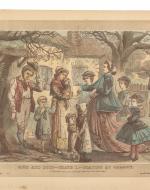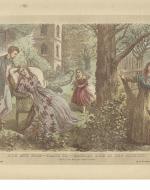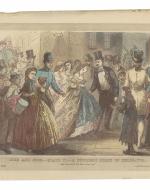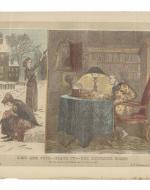Exhibit:
Preview of images
Parent Resource
These four elaborate color prints, executed by Robert Prowse (1826-86) were distributed "Gratis" with the first number (10 February, 1866) of The London Miscellany. This periodical was edited by James Malcolm Rymer and carried his penny dreadful A Mystery in Scarlet as its first "leading serial," or serial printed on the front page of consecutive issues. The prominent positioning of the leading serial made it imperative that it be both visually attractive and dramatically effective. They are included here in the Exhibits section of this edition because they are not a part of the Wells Library copy of The London Miscellany provided in facsimile in the Appendices.
Prowse's four prints preview Rymer's miniature serial Rich and Poor (London Miscellany no. 3 and 4). Like other pull-out prints disseminated with penny periodicals, these were evidently designed to be displayed as wall art in the homes of the target readers, working-class families. We can therefore imagine these families reading A Mystery in Scarlet in domestic spaces decorated, at least momentarily, with Prowse's prints. Such decor must have reinforced some of the political rhetoric of A Mystery in Scarlet, such as the serial's justification of universal male suffrage, its championship of young men's potential to act as citizens, and its critique of monarchy and oligarchy.
Prowse was a prolific illustrator of penny dreadfuls who flourished in the 1860s and 1870s. He achieved notoriety for some of the illustrations of Charles H. Ross's Charley Wag, the New Jack Sheppard (1860-1). As John Springhall has observed, one of Prowse's Charley Wag illustrations "shows a grinning Charley fleeing confidently down the Strand ... with a stolen goose and two bottles of rum, hotly pursued by a policeman brandishing a truncheon, and egged on by a smiling crowd ... while a notice on a nearby wall offers £500 for the boy burglar's capture." Charley's exploits also include a daring Tower of London heist, an obvious challenge to the authority of the British state (Springhall 62). Prowse follows up on his outlaw theme in his illustration of other dreadfuls, including an 1880s edition of Percy Bolingbroke St. John's 1869 Dick Turpin adventure The Blue Dwarf, A Tale of Mystery, Love, and Crime. Despite Prowse’s provocative content, his contemporaries "rated [him] amongst the best of the woodcut artists working in the field" of periodical fiction illustration (Holland). He is not to be confused with his son, Robert Prowse, Jr (1858-?1934), also an artist and engraver.
In the Rich and Poor illustrations, Prowse's depiction of Britain's virtuous poor and idle rich promotes working-class pride and self-determination, as do other contents of The London Miscellany. The images are printed in pairs on two sheets of folded paper. Prowse has initialled each image in the lower lefthand corner, as he did several of his other known works. The verso of each sheet is blank. There are no visible plate marks. Images derive from the unbound (that is, never-bound) copy of the London Miscellany, no. 1 in the collection of the Lilly Library, Indiana University, Bloomington, Indiana. Images courtesy Lilly Library.
Works Cited:
Holland, Steve. "A Tale of Two Roberts." Yesterday's Papers. January 2010. Accessed 6/28/2018.
Springhall, John. Youth, Popular Culture and Moral Panics: Penny Gaffs to Gangsta-Rap, 1830–1996. Macmillan, 1999.




